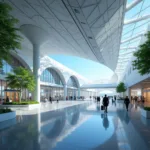Commercial Airports are vital hubs of global connectivity, facilitating the movement of people and goods across vast distances. They are complex ecosystems, combining infrastructure, technology, and human resources to ensure safe and efficient operations. This article delves into the intricacies of commercial airports, exploring their various facets, from their historical evolution to the challenges and opportunities they face in the 21st century. Learn more about the critical role these airports play in our interconnected world.
The Evolution of the Commercial Airport
From humble beginnings as grassy airfields, commercial airports have transformed into sophisticated transportation hubs. The earliest commercial flights were primarily mail services, gradually evolving to carry passengers as aircraft technology advanced. The post-World War II era saw a surge in air travel, leading to the development of larger aircraft and the expansion of airport infrastructure. The jet age further revolutionized air travel, demanding even more significant changes to airport design and capacity. Today, mega-hubs like Dubai International and Heathrow handle millions of passengers annually, showcasing the incredible growth and evolution of the commercial airport.
Key Components of a Commercial Airport
A commercial airport comprises several interconnected components working in harmony. The airside, including runways and taxiways, is where aircraft movements take place. The terminal building houses passenger processing areas, such as check-in counters, security checkpoints, and baggage claim. chittagong airport could be considered an example of how these components work together. Support facilities, such as hangars for maintenance and fueling stations, are also crucial for smooth operations. Furthermore, air traffic control towers play a critical role in managing aircraft movements, ensuring safety and efficiency.
How Does a Commercial Airport Function?
The daily operations of a commercial airport are a complex choreography of coordinated activities. Passenger processing involves check-in, security screening, and baggage handling. Aircraft operations encompass arrival, departure, and ground handling procedures. “Efficient coordination between various stakeholders, including airlines, ground handling companies, and airport authorities, is paramount for seamless operations,” says Dr. Amelia Reyes, an aviation consultant with over 20 years of experience. Furthermore, commercial airports are businesses, generating revenue through various channels, including landing fees, passenger charges, and concessions. The economic impact of a commercial airport extends beyond its boundaries, contributing to local and regional economies through job creation and tourism.
Challenges and Opportunities for Commercial Airports
The commercial airport sector faces several challenges in the 21st century. Growing passenger demand necessitates continuous infrastructure expansion. Environmental concerns are driving the need for sustainable airport operations. 3 bedroom apartments near denver airport demonstrate the increasing urbanization around airports and the subsequent need for careful planning. “Technological advancements, such as automated passenger processing and biometric identification, offer opportunities to enhance efficiency and security,” states Mr. David Lee, a senior airport planner. row airport is an example of an airport constantly adapting to new technologies. Furthermore, the rise of low-cost carriers and the increasing popularity of air travel continue to reshape the landscape of the commercial airport industry. sonbhadra airport highlights the expansion of airport infrastructure to cater to growing demand. what is greenfield airport further explores the concept of building entirely new airports to accommodate future growth.
Conclusion
Commercial airports are essential gateways to the world, playing a pivotal role in facilitating global connectivity. Their continuous evolution and adaptation to changing demands are crucial for the future of air travel. Understanding the complexities of commercial airports, from their historical development to their current challenges and opportunities, allows us to appreciate their vital role in our interconnected world.
For assistance, please contact us at Phone: +13089626264, Email: [email protected], or visit our office at 404 Bothwell St, Oxford, NE 68967, USA. Our customer service team is available 24/7.

